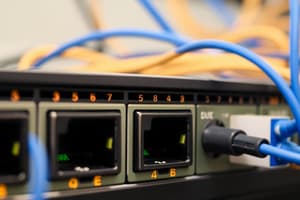Podcast
Questions and Answers
What defines a LAN (Local Area Network)?
What defines a LAN (Local Area Network)?
- Is only used in large corporate offices.
- Covers a small geographic area and has high-speed bandwidth. (correct)
- Is always managed by a single service provider only.
- Connects multiple cities through high-speed connections.
Which of the following best describes the Internet?
Which of the following best describes the Internet?
- A private network only accessible to specific users.
- A global collection of LANs and WANs connected through various media. (correct)
- A single network managed by one entity.
- Primarily used for local communication within homes.
What is an example of an intermediary device?
What is an example of an intermediary device?
- Smartphone
- Web Browser
- Network Cable
- Router (correct)
Fault tolerance in network architecture refers to what?
Fault tolerance in network architecture refers to what?
Which statement is true about BYOD (Bring Your Own Device)?
Which statement is true about BYOD (Bring Your Own Device)?
What type of threat is an external security breach like hacking classified as?
What type of threat is an external security breach like hacking classified as?
Which of the following terms best describes the layout of a network?
Which of the following terms best describes the layout of a network?
What is packet switching used for in networking?
What is packet switching used for in networking?
A LAN connects devices over large geographic areas like cities and countries.
A LAN connects devices over large geographic areas like cities and countries.
The Internet is a global collection of LANs and WANs connected using various media.
The Internet is a global collection of LANs and WANs connected using various media.
Intermediary devices are responsible for generating messages in a network.
Intermediary devices are responsible for generating messages in a network.
Fault tolerance in network architecture helps to minimize failures through redundancy.
Fault tolerance in network architecture helps to minimize failures through redundancy.
Scalability allows a network to grow without any loss in performance.
Scalability allows a network to grow without any loss in performance.
BYOD stands for Bring Your Own Device and encourages employees to use personal devices for work purposes.
BYOD stands for Bring Your Own Device and encourages employees to use personal devices for work purposes.
External threats to network security include accidental breaches by employees.
External threats to network security include accidental breaches by employees.
Packet switching improves fault tolerance by splitting traffic into packets.
Packet switching improves fault tolerance by splitting traffic into packets.
A WAN (Wide Area Network) connects devices in a small geographic area like a home or office.
A WAN (Wide Area Network) connects devices in a small geographic area like a home or office.
End devices in a network are where messages originate or are received.
End devices in a network are where messages originate or are received.
Cloud computing refers to storing data locally on a personal device.
Cloud computing refers to storing data locally on a personal device.
Quality of Service (QoS) prioritizes certain types of data in network management.
Quality of Service (QoS) prioritizes certain types of data in network management.
The integration of technology into everyday appliances is referred to as Smart Devices.
The integration of technology into everyday appliances is referred to as Smart Devices.
What is a characteristic of a scalable network?
What is a characteristic of a scalable network?
Which type of networking trend involves using personal devices to access work resources?
Which type of networking trend involves using personal devices to access work resources?
Which of the following correctly describes an intermediary device's role in a network?
Which of the following correctly describes an intermediary device's role in a network?
What is a common internal threat to network security?
What is a common internal threat to network security?
Which media type is NOT commonly used for connecting networks?
Which media type is NOT commonly used for connecting networks?
Flashcards
LAN
LAN
A local area network that covers a small geographical area, such as a home, office, or campus. It typically has high-speed bandwidth and a single administration.
WAN
WAN
A wide area network that connects LANs over large geographical areas, like cities or countries. It's managed by multiple service providers, often with slower speeds.
Network Components
Network Components
The various parts that make up a network. These include end devices—where communication originates or ends (e.g., computers, phones)—intermediary devices—that manage the flow of data (e.g., routers, switches)—and media types—how data travels (e.g., copper, fiber optics).
Network Reliability
Network Reliability
Signup and view all the flashcards
BYOD
BYOD
Signup and view all the flashcards
Cloud Computing
Cloud Computing
Signup and view all the flashcards
Packet Switching
Packet Switching
Signup and view all the flashcards
Network Topology
Network Topology
Signup and view all the flashcards
What is a network?
What is a network?
Signup and view all the flashcards
What are the types of networks?
What are the types of networks?
Signup and view all the flashcards
What is a router?
What is a router?
Signup and view all the flashcards
What is the purpose of a firewall?
What is the purpose of a firewall?
Signup and view all the flashcards
What is fault tolerance?
What is fault tolerance?
Signup and view all the flashcards
What is BYOD?
What is BYOD?
Signup and view all the flashcards
What is cloud computing?
What is cloud computing?
Signup and view all the flashcards
What is a network topology?
What is a network topology?
Signup and view all the flashcards
What are network components?
What are network components?
Signup and view all the flashcards
What does 'fault tolerance' mean?
What does 'fault tolerance' mean?
Signup and view all the flashcards
What are intermediary devices?
What are intermediary devices?
Signup and view all the flashcards
What are the benefits of a reliable network?
What are the benefits of a reliable network?
Signup and view all the flashcards
What are threats to network security?
What are threats to network security?
Signup and view all the flashcards
Quality of Service (QoS)
Quality of Service (QoS)
Signup and view all the flashcards
Study Notes
Introduction to Networks
- Networks facilitate global communication, learning, work, and entertainment.
- Communication methods include texting, social media, online collaboration, blogs, and gaming.
Types of Networks
- LAN (Local Area Network): Covers a small area (home, office, campus) with high-speed, single administration.
- WAN (Wide Area Network): Spans large areas (cities, countries), managed by multiple providers, slower speeds than LANs.
- Internet: A global network composed of interconnected LANs and WANs, using copper, fiber optic, and wireless connections.
Network Components
- End Devices: Devices where messages begin or end (computers, phones).
- Intermediary Devices: Manage data flow (routers, switches, firewalls).
- Media Types: Copper cables, fiber optics, wireless technologies.
Network Architectures
- Fault Tolerance: Redundancy in network design to minimize disruptions.
- Scalability: The ability to expand the network without performance issues.
- Quality of Service (QoS): Prioritizes certain data types (e.g., video, voice).
- Security: Protecting network infrastructure and data (confidentiality, integrity, availability).
Networking Trends
- BYOD (Bring Your Own Device): Employees using personal devices for work.
- Cloud Computing: Storing and accessing data over the internet (public, private, hybrid).
- Online Collaboration and Video Communication: Tools like Cisco WebEx and TelePresence.
- Smart Homes: Integration of technology into domestic appliances.
Security
- Threats: Risks to networks include external threats (viruses, hacking, Denial-of-Service attacks) and internal threats (employee errors or malicious intent).
- Solutions: Home networks use antivirus and firewalls; large networks employ access control lists, intrusion prevention systems, and virtual private networks (VPNs).
Key Terms
- Topology: The physical or logical layout of a network.
- NIC (Network Interface Card): Connects a device to the network.
- Packet Switching: Dividing data into packets for efficient and resilient transmission.
Studying That Suits You
Use AI to generate personalized quizzes and flashcards to suit your learning preferences.




